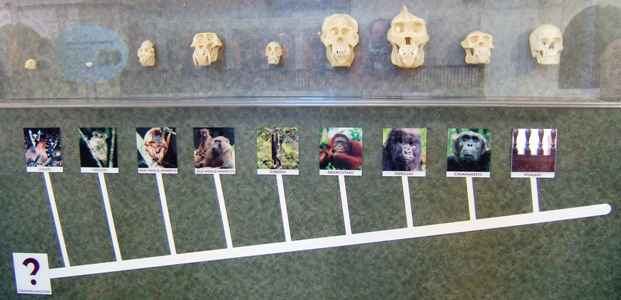| In the main hall of the Museum of Man are these replica
pillars called stela. They are Mayan from Quirigua (in Guatemala) and were
dedicated by the king K'ak' Tiriw on 19th February 766AD to
commemorate the ending of one time period and the start of a new one. They
were first photographed in 1885 and these casts were made on site in 1914. |  |
 | They are particularly
fine examples of hieroglyphics from the Mayan classical period and the
plaques seen above give a lot of detail about the advanced civilization at
that time. The kings were thought to be gods and had exceptionally high
headdresses full of symbolism. |
| This is a mosaic
tile on the wall, also from the Mayan civilisation. We could see no explanation
of its origin. |  |
 | Upstairs is another exhibition on the origins of man
which started with these skeletons. One is homo sapiens and the other is
a human progenitor. |
| This is a reconstruction of the major find known as Lucy. It is now thought that this small ape
(about 3 feet tall) may be part of the missing link between apes and humans
because she walked
upright. |  |
 | These are the skulls from various primates in the ape family
leading up to man suggesting a link between them all. |
| This is an artist's
recreation of Cro Magnon man. I guess you have to be
knowledgeable about the finer points of human archeology to fully appreciate
this display. |  |
 | The Museum of Man was
once a church and a side chapel with this altar still exists. Note the monks
on either side. This is similar to the Mission altar which we found in
Santa Barbara and probably dates from the same period. |
| There are several exhibitions of Native American artifacts. Some
of the basketwork is amazing. This is a modern basket demonstrating the
artwork now being produced. If these baskets are lined with pine pitch they
become waterproof. |  |
 | Another display
showed artifacts from the culture of native Californians called the Kumeyaay.
This pot was made as an experiment using what was believed to be their
traditional processes. |
| Another modern interpretation of Kumeyaay images. This one looked
quite cuddly... |  |
 | unlike this one which
seemed to be a cross between a scorpion and a dragon. |
| Jan really enjoyed the exhibition in the annexe. It is called the
Art of Kuna, and is a display of blouses stitched by hand by women from
Panama. |  |
 | The designs are based
on traditional motifs and very colourful, and there are lots of photographs
showing women sitting and working together outside their houses, rather like
American women making quilts together. |
| The Egyptian exhibit contained this mummy along with the funerary dolls which were
buried with the mummies. |  |
 | There were a number of mummies and other Egyptian artifacts.
This was quite a comprehensive collection if you are interested in this
period. |
| A lot of the funerary
dolls were painted whilst others were left unpainted. There were many
different sorts in differing sizes. |  |
|